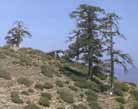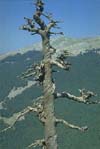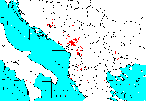 Pinus heldreichii growing above a carpet of Buxus sempervirens on the road to Prioni (Greece) at Katara Pass, 1700m.  Immature cones on a specimen in the same area (7).  Bark of a tree growing in the same area (7).  A representative stand of old trees, variety leucodermis (11).  A picturesque specimen of var. leucodermis in Pollino National Park, Italy (9).  A snag of var. leucodermis in Pollino National Park, Italy (12). Spiral grain is very common in members of the Pinaceae growing in stressful environments. It may occur in response to various causes, the most common being asymmetry in the root system (13).  Distribution of P. heldreichii, redrawn from (14). |
Pinus heldreichii Christ
Common NamesMunika, cherna mura [=Black pine: Bulgarian, Serbian], whitebark pine, Heldreich pine, Bosnian pine [English], Panzerkiefer [German], pin d'ecorce blanche [French], il pino loricato [Italian] (8), robolo [Greek]; var. leucodermis called palebark pine (2) or Bosnian pine (3).Taxonomic notesOne variety, leucodermis (Antoine) Markgraf ex Fitschen (syn: P. leucodermis Antoine; P. laricio var. leucodermis (Ant.) Christ) (1, 3). This variety is often treated as a distinct species, particularly by the Italians, who are rightly proud of it. Of the 16 species with which it shares subsection Pinus, it most nearly resembles P. nigra (3).DescriptionTree: Height to 20(35) m, but often shrubby; dbh to more than 2 m; habit pyramidal to oval (4, 8).Bark: Very thick, ash-gray, flaking to leave yellow patches, breaking into large plates (3, 4, 8). Branches: Whorled, upward-curving, esp. on young trees. Twigs twigs glaucous, turning brown at end of first year (3, 4). Leaves: Fascicles of 2, 6-11 cm long, 1.5 mm thick, stiff, sharp, green, in whorls about twigs, retained 2-6 years. Buds brown, not resinous, 15 mm diameter (3, 4, 5). Pollen cones: Bright yellow, in dense clusters at the base of the shoot (3). Seed cones: In clusters of 2-4 on short peduncles, 7-9 cm long and 2.5 cm wide with a flat base and thin, weak scales, opening when ripe. Umbo very short, often missing. Flowers from May to June, cones ripening in September and October of the second year (3, 8). Seed: 7 mm long, with a wing 25 mm long (8). Var. leucodermis differs in being taller (to 30 m) with bark smooth and pale green-gray, later breaking into small plates. Young twigs are glaucous, white to grey-pink for three years, turning brown. Foliage is dark green (3, 4). First-year seed cones are dark purple (3) or cobalt blue (4). RangeThe type variety is found in the W Balkan Peninsula (1), incl. Albania, Bulgaria, Greece and Yugoslavia (4), where is usually is found in mixed stands at 1000-2500 m elevation, reaching the alpine timberline amidst Pinus mugo (3, 5, 15). Common associates include Pinus sylvestris, P. peuce and P. nigra (15). Var. leucodermis is found in S Italy, Albania, Yugoslavia, Greece (1, IUCN), at 900-2500 m elevation on dry, sunny sites where it forms mixed stands with Abies & Fagus (3, 5), pure stands occurring only on steep and dry rocky southern slopes (8). Both varieties are USDA Zone 6 (4) and typically occur on soils derived from calcareous (limestone, dolomite) or occasionally ultramafic parent materials. Together with P. mugo and P. uncinata, P. heldreichii is one of the high-elevation pines of the Mediterreanean basin (5, 6).Big TreeI have seen a photograph (10) of a huge tree on Mt. Pindos in Greece that probably measures at least 220 cm dbh.OldestDuring a dendrochronological study, a specimen of var. leucodermis aged 963 years (in 1989) was collected on Mt. Pollino at the Parco del Pollino in southern Italy (approx. 39deg 50' N, 16deg 15' E). The specimen was cored ca. 1 m above ground level; most of the record is verified by crossdating (2).For a long time it was believed that a specimen of this species, called the 'Baikushevata mura', was the oldest tree in Bulgaria. The tree is in Pirin National Park near the highest peak Vihren at an elevation of approximately 1750 m. Its age was estimated (data source unknown) to be over 1300 years old. It was"officially' The Oldest Tree in Bulgaria until some 20 years ago (?) a common oak (Quercus robur) which was long known as an very old tree was claimed to be over 1600 years old (15). DendrochronologyAs noted above, var. leucodermis has been collected on Mt. Pollino in Italy.EthnobotanyVar. leucodermis is a popular ornamental, with several cultivars in use (4).ObservationsValia-Calda National Park, in Greece, sounds like a good place to see the type variety; here it grows to the summit of Mt. Pindos, 2177 m. In Bulgaria it is native in Mount Pirin (also a good place to find Pinus peuce), where the entire population is protected within a National Park; and farther south in Mount Slavyanka, protected there as a Natural Reserve (15). The best place to see var. leucodermis is Il Parco Nazionale del Pollino (Pollino National Park); use your Web browser to fins a few of the many sites devoted to this park, starting HERE (9).RemarksThe type variety is listed as vulnerable and var. leucodermis is listed as 'lower risk' by the World Conservation Monitoring Centre - Trees database.Citations(1) Silba 1986.(2) Franco Biondi. 1992. Development of a tree-ring network for the Italian peninsula. Tree-Ring Bulletin 52: 15-29. (3) Farjon 1984. (4) Rushforth 1987. (5) Richardson & Rundel 1998. (6) Barbero et al., 'Pines of the Medierreanean Basin', p.153-171 in Richardson 1998. (7) Hayter, Jane. 1994. Northern Greece. International Dendrological Society Yearbook, pp.104-124. (8) M. JankoviŠ. 1986."Pinus heldreichii," in Flora Srbije. Belgrade: Serbian Academy of Sciences and Arts. (9) Parco Nazionale del Pollino. Web site at http://www.telsa.it/castrovillari/proloco/parco/parco.htm, accessed 23-Feb-1999. (10) No title. Web page at http://www.abdn.ac.uk/~for284/pics/pic10.htm, accessed 23-Feb-1999. (11) Il Pino loricato. Web page at http://entoma.unibas.it/pinoloricato.htm, accessed 23-Feb-1999. (12) Pino elicoidale (a Pollinello). Web page at http://194.243.119.70/pollino/pinoeli/pinoeli.htm, accessed 23-Feb-1999. (13) Hans Kubler. 1991. Function of spiral grain in trees. Trees 5: 125-135. (14) Critchfield & Little 1966. (15) Hristo Dimitrov Stankov, e-mail communication, 30-Jun-1999. Thanks to Milan Jovanovic for information and assistance contributed Feb-1999. |
|
[Pinus] [Pinaceae] [home] This page is from the Gymnosperm Database
|